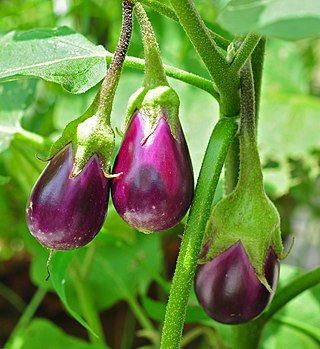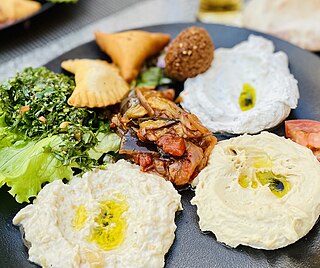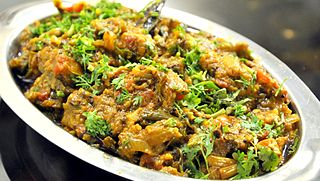 | |
| Type | Salad |
|---|---|
| Main ingredients | Eggplants |
Many cuisines feature eggplant salads and appetizers.
 | |
| Type | Salad |
|---|---|
| Main ingredients | Eggplants |
Many cuisines feature eggplant salads and appetizers.
This section needs additional citations for verification .(August 2021) |
Baba ghanoush (Arabic : بابا غنوجbābā ghanūj) is a popular Levantine dish of eggplant (aubergine) mashed and mixed with various seasonings. Frequently the eggplant is baked or broiled over an open flame before peeling, so that the pulp is soft and has a smoky taste. [1] Baba ghanoush is usually eaten as a dip with pita bread, and is sometimes added to other dishes. It is usually of an earthy light brown color. In Ethiopia, this dish is commonly known as blagadoush.

Similar to baba ghanoush is another Levantine dish mutabbal (متبل lit. 'spiced'), which also includes mashed cooked aubergines and tahini, and mixed with salt, pepper, olive oil, and anar seeds. Mutabbal is sometimes said to be a spicier version of baba ghanoush.
In Armenia, the dish is known as mutabal. The essential ingredients in Armenian mutabal are eggplant, tahini, garlic, lemon, and onion; and most Armenians also add cumin.

Georgian badrijnis khizilala ("aubergine caviar") is made of fried and chopped eggplants. Further typical ingredients are onions, garlic, pomegranate, hot red pepper, vegetable oil and fresh green cilantro. [2]
In Israel, the traditional version called salat ḥatzilim is made with mashed grilled aubergines, tahini, olive oil, lemon, garlic and parsley. A variation made with mayonnaise instead of tahini, called salat ḥatzilim b'mayonnaise, is also widely available. [3]
In Morocco, a fried eggplant dish made with tomatoes, garlic, olive oil, cumin, paprika and parsley is called zaalouk . [4]
Eggplant relish is middle eastern-north African dish. [5] It is made of eggplant, salt, olive oil, lemon, and parsley.
In Egypt, Papa Ghannug is made of grilled then peeled eggplant with tahini, water, salt, pepper, lemon, and small parts of stem of parsley. Papa Ghannug is eaten with bread.
In Iranian cuisine, eggplant is prepared into an appetizer known as kashk bademjan and Mirza Ghasemi. It is made with whey sauce (kashk). [6]

In Greece and Cyprus, melitzanosalata (μελιτζανοσαλάτα; "eggplant salad") is made with olive oil and lemon juice. [7] [8] Other ingredients typically include garlic, onion, and parsley. Sometimes spices like cumin and red pepper flakes are added. Garnishes may include feta cheese or olives. [9] [10]
In Turkish cuisine, İmam bayıldı is an eggplant stew, commonly prepared with olive oil, onions and tomatoes. The dish is known in Greece as Ιμάμ μπαϊλντί (Imam bayildi) or just imam.
Malidzano , a traditional Macedonian spread, is made from puréed eggplants, sirenje cheese, walnuts and spices. It is usually served as appetizer along with bread. In other countries of Western Balkans (Serbia, Bosnia and Herzegovina, Croatia) it is prepared from green peppers and eggplant.

Salată de vinete (Eggplant salad) or simply vinete is a Romanian, Moldovan and Hungarian mashed eggplant salad made of grilled, peeled and finely chopped eggplants, sunflower oil and chopped onions. The eggplants are grilled on an open flame until they are covered with black ash crust. The crust is cleaned off and the remaining cooked eggplant is mashed with a blunt, thick wooden cleaver (knife) on a wooden platter (popular belief has it that using a metal knife will turn the eggplant flesh black, before stainless steel blades, but also because cutting through the seeds is to be avoided). The eggplant mash is mixed in a bowl, stirring continuously, with sunflower oil, chopped onions and salt. The mix is beaten vigorously. Crushed garlic and ground pepper may be added too. Instead of oil, mayonnaise can be used, although not traditionally. A zest of lemon is added at the end and the platter is sometimes garnished with tomato slices.
A typical zakuska in Russia and Ukraine (especially Odesa) is known as baklažannaja ikra (Russian : баклажанная икра) or baklažanna ikra (Ukrainian : баклажанна ікра), literally meaning "aubergine caviar". Some versions add chopped tomatoes to the basic recipe. [11] Another eggplant salad popular in Russia is called he iz baklažanov (Russian: хе из баклажанов), and it is probably influenced by Korean cuisine. Eggplant he is based on julienned (instead of mashed) cooked aubergines and other vegetables, prepared with concentrated vinegar. After adding the vinegar, it is set aside for several hours to cure before eating.

In Turkey, a similar meze is called patlıcan salatası ("eggplant salad"). [12] It is made with grilled mashed eggplant, olive oil, lemon juice and garlic; sometimes, tahini, chopped tomato and green pepper as well. More frequently, eggplant is mixed with yoghurt, olive oil and garlic. The version with cut eggplants can be found in southern Turkey, especially in Antakya. In other varieties, called şakşuka or köpoğlu , roasted and chopped eggplants and peppers are served with garlic yogurt or tomato sauce. The latter is also a typical eggplant appetizer in Bulgaria, where it is called kyopolou . Hünkarbeğendi is another Turkish dish, which is a mutton or lamb (nowadays also veal) stew where the meat is served hot on a bed of eggplant purée. The purée also contains kaşar cheese, milk and flour. [13]
In Indian and Pakistani cuisine, an eggplant dish, by the name of baingan bartha , is popular especially in the regions of Punjab, [14] Maharashtra, Bihar, Orissa and West Bengal. It is also eaten across Pakistan, as well as in Bangladesh. The dish has many names, depending on the local language (Hindi: baingan ka bharta, Bengali : বেগুন ভর্তা begun bhôrta, Marathi: wangyacha bharit).

In the South Indian state of Tamil Nadu, the Tamils prepare kathrikai thayir kothsu, in which the eggplant is cooked, mashed and sautéed with mustard, red chili peppers, and sesame oil, after which yogurt is added to the mixture and dressed with cilantro coriander leaves. [15] It is often eaten with an Indian flatbread (specifically roti or paratha), and is also served with rice, and/or raita (a yoghurt salad).
Kashmiris prepare a spicy and tangy dish of eggplants called choek wangun with tamarind constituting an important part of the gravy. [16]
Eggplant mud (茄泥) is a Chinese recipe of steamed and mashed eggplant. It is served with dressings such as pounded garlic with soy sauce. In Sichuan cuisine many people also like to add hot peppers and cilantro. It is a common lunch dish and may be eaten with rice or rolls.
Mashed eggplant is also part of Hmong cuisine and it contains hot peppers and cilantro.
In Korea, steamed or poached strips of eggplant seasoned with garlic, toasted sesame oil and chili is a common side dish called 가지나물 (gaji namul, literally “eggplant salad.”)

Caviar d'aubergine is prepared in southern France. Baked, peeled aubergine is mixed with garlic, tomato, parsley, lemon juice, and finally olive oil. It is served as an appetizer with French bread, possibly along with olive tapenade.
Caponata is a Sicilian eggplant relish made from chopped fried vegetables (mostly eggplants and peppers), seasoned with celery, olives and capers, in a sweet sour sauce. Today, caponata is typically used as a side dish or appetizer, but, since the 18th century, it has sometimes been used as a main course.
Berenjena a la vinagreta is a typical appetizer in Hispanosphere made from boiled eggplants in a vinaigrette. The eggplant is usually salted to remove moisture then boiled until soft and then placed into a vinaigrette with garlic and various herbs or spices. In Argentina the eggplants will rest in the vinaigrette, often containing plenty of oil, for several days and then is eaten as part of a picada before a meal. In Spain, it can be found along other pinchos at tapas bars. In Catalonia region, eggplant is roasted and seasoned with olive oil in the dish escalivada.
In the 1973 Soviet film comedy Ivan Vasilievich: Back to the Future , which partly takes place in the reign of Ivan the Terrible, a lavish royal banquet features several tub-sized bowls of genuine sturgeon caviar and red caviar, and a tiny golden dish of "eggplant caviar from overseas". The joke is that in 16th-century Moscow, eggplants would have been hard-to-obtain luxuries compared with Caspian Sea sturgeon caviar. [17]

Turkish cuisine is the cuisine of Turkey and the Turkish diaspora. Although the cuisine took its current rich form after numerous cultural interactions throughout centuries, it should not be confused with other cuisines such as Ottoman cuisine or Seljuk cuisine. Turkish cuisine with traditional Turkic elements such as yogurt, ayran, kaymak, exerts and gains influences to and from Mediterranean, Balkan, Middle Eastern, Central Asian and Eastern European cuisines.

Eggplant, aubergine, brinjal, or baigan is a plant species in the nightshade family Solanaceae. Solanum melongena is grown worldwide for its edible fruit.

Baba ghanoush, also spelled baba ganoush or baba ghanouj, is a Levantine appetizer consisting of finely chopped roasted eggplant, olive oil, lemon juice, various seasonings, and tahini. The eggplant is traditionally roasted, baked or broiled over an open flame before peeling, so that the pulp is soft and has a smoky taste. It is a typical meze (starter) of the regional cuisine, often served as a side to a main meal and as a dip for pita bread.

Arab cuisine collectively refers to the regional culinary traditions of the Arab world, consisting of the Maghreb and the Mashriq. These cuisines are centuries old and reflect the culture of trading in ingredients, spices, herbs, and commodities among the Arabs. The regions have many similarities, but also unique traditions. They have also been influenced by climate, cultivation, and mutual commerce.

Iraqi cuisine is a Middle Eastern cuisine that has its origins in the ancient Near East culture of the fertile crescent. Tablets found in ancient ruins in Iraq show recipes prepared in the temples during religious festivals—the first cookbooks in the world. Ancient Iraq's cultural sophistication extended to the culinary arts.

Cypriot cuisine is the cuisine of the island of Cyprus, shared by both Greek Cypriots and Turkish Cypriots.

Levantine cuisine is the traditional cuisine of the Levant, in the sense of the rough area of former Ottoman Syria. The cuisine has similarities with Egyptian cuisine, North African cuisine and Ottoman cuisine. It is particularly known for its meze spreads of hot and cold dishes, most notably among them ful medames, hummus, tabbouleh and baba ghanoush, accompanied by bread.

Lebanese cuisine is the culinary traditions and practices originating from Lebanon. It includes an abundance of whole grains, fruits, vegetables, fresh fish and seafood. Poultry is eaten more often than red meat, and when red meat is eaten, it is usually lamb and goat meat. Dishes include copious amounts of garlic and olive oil, and dishes are often seasoned with salt and lemon juice. Chickpeas and parsley are also staples of the Lebanese diet.

Mirza ghassemi or mirza qassemi is a Gilani cuisine, appetizer or main course based on tandoori or grilled aubergine (eggplant), distinct to the Northern Iran and Caspian Sea region ..

Palestinian cuisine consists of foods from or commonly eaten by Palestinians or in the region of Palestine, whether in Palestine, Israel, Jordan, or refugee camps in nearby countries, or by the Palestinian diaspora. The cuisine is a diffusion of the cultures of civilizations that settled in the region of Palestine, particularly during and after the Islamic era beginning with the Arab Ummayad conquest, then the eventual Persian-influenced Abbasids and ending with the strong influences of Turkish cuisine, resulting from the coming of the Ottoman Turks. It is similar to other Levantine cuisines, including Lebanese, Syrian and Jordanian.

Israeli cuisine primarily comprises dishes brought from the Jewish diaspora, and has more recently been defined by the development of a notable fusion cuisine characterized by the mixing of Jewish cuisine and Arab cuisine. It also blends together the culinary traditions of the various diaspora groups, namely those of Middle Eastern Jews with roots in Southwest Asia and North Africa, Sephardi Jews from Iberia, and Ashkenazi Jews from Central and Eastern Europe.

Tunisian cuisine, the cuisine of Tunisia, consists of the cooking traditions, ingredients, recipes and techniques developed in Tunisia since antiquity. It is mainly a blend of Mediterranean and native Berber cuisine with Punic influences. Historically, Tunisian cuisine witnessed influence and exchanges with many cultures and nations like Italians, Andalusians, French and Arabs.

Baigan bharta, also spelled bainganbharta or baigan chokha is an Indian dish prepared by mashing or mincing grilled eggplant (baigan) with tomato, onion, herbs and spices, with variations being common from chef to chef. Traditionally, cooking the eggplants over charcoals, inside of a tandoor, barbecue grill or oven, or even directly applying flame to the outside of the fruit infuses the dish with a smoky flavour; the blackened skin is then easily peeled and the eggplant may be further prepared.

The Algerian Cuisine includes multiple flavors and influences, reflecting the country's history and position at the crossroads of the Mediterranean.

Mizrahi Jewish cuisine is an assortment of cooking traditions that developed among the Mizrahi Jewish communities of the Middle East, North Africa and Central Asia. Influenced by the diverse local culinary practices of countries such as Morocco, Libya, Egypt, Iraq, Iran, Yemen, and Syria, Mizrahi cuisine prominently features rice, legumes, meats, and an array of spices such as cumin, turmeric, and coriander. Signature dishes include kubbeh (dumplings), pilafs, grilled meats, and stews like hamin.
The Sofra is a restaurant chain in London, United Kingdom, which serves Turkish cuisine. The chef patron is Hüseyin Özer. It was established in 1981 as a small restaurant, which turned later into a chain of restaurants, currently in Mayfair and St Christopher's Place, off Oxford Street. Sofra restaurants are regarded the best Turkish cuisine restaurants outside Turkey, ranking first in a list published by the newspaper Hürriyet.

Middle Eastern cuisine or West Asian cuisine includes a number of cuisines from the Middle East. Common ingredients include olives and olive oil, pitas, honey, sesame seeds, dates, sumac, chickpeas, mint, rice and parsley, and popular dishes include kebabs, dolmas, falafel, baklava, yogurt, doner kebab, shawarma and mulukhiyah.